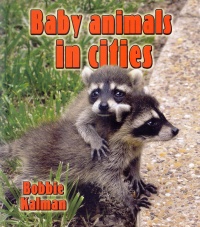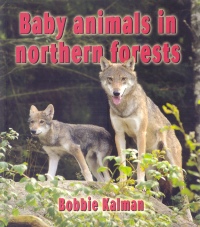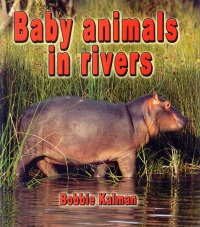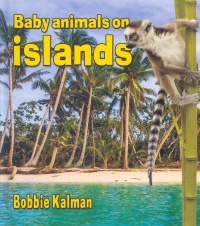| ________________
CM . . .
. Volume XIX Number 36. . . .May 17, 2013 
 |
Baby Animals in Cities. (The Habitats of Baby Animals).
Bobbie Kalman.
St. Catharines, ON: Crabtree, 2013.
24 pp., pbk. & hc., $7.95 (pbk.), $18.36 (RLB.).
ISBN 978-0-7787-1029-5 (pbk.), ISBN 978-0-7787-1017-2 (RLB.).
Subject Headings:
Urban animals-Infancy-Juvenile literature.
Urban ecology (Biology)-Juvenile literature.
Grades 2-4 / Ages 7-9.
Review by Suzanne Pierson.
**½ /4
|
| |
|
 |
Baby Animals in Northern Forests. (The Habitats of Baby Animals).
Bobbie Kalman.
St. Catharines, ON: Crabtree, 2013.
24 pp., pbk. & hc., $7.95 (pbk.), $18.36 (RLB.).
ISBN 978-0-7787-1031-8 (pbk.), ISBN 978-0-7787-1018-9 (RLB.).
Subject Headings:
Taiga animals-Infancy-Juvenile literature.
Taiga ecology-Juvenile literature.
Grades 2-4 / Ages 7-9.
Review by Suzanne Pierson.
**½ /4
|
| |
|
 |
Baby Animals in Rivers. (The Habitats of Baby Animals).
Bobbie Kalman.
St. Catharines, ON: Crabtree, 2013.
24 pp., pbk. & hc., $7.95 (pbk.), $18.36 (RLB.).
ISBN 978-0-7787-1033-2 (pbk.), ISBN 978-0-7787-1019-6 (RLB.).
Subject Headings:
Stream animals-Infancy-Juvenile literature.
Stream ecology-Juvenile literature
Grades 2-4 / Ages 7-9.
Review by Suzanne Pierson.
**½ /4
|
| |
|
 |
Baby Animals on Islands. (The Habitats of Baby Animals).
Bobbie Kalman.
St. Catharines, ON: Crabtree, 2013.
24 pp., pbk. & hc., $7.95 (pbk.), $18.36 (RLB.).
ISBN 978-0-7787-1027-1 (pbk.), ISBN 978-0-7787-1016-5 (RLB.).
Subject Headings:
Island animals-Infancy-Juvenile literature.
Island ecology-Juvenile literature.
Grades 2-4 / Ages 7-9.
Review by Suzanne Pierson.
**½ /4
|
| |
|

excerpt:
Madagascar is an island that is part of the continent of Africa. It is the only place where lemurs and some other animals can be found. Animals that live only in certain places are said to be endemic to those areas. The animals on these pages are endemic to Madagascar. (From Baby Animals on Islands.)
These new books in “The Habitats of Baby Animals” series have the same strengths and weaknesses as earlier books in the series. Information is presented in a relatively simple format amply illustrated by colourful photographs. Unfortunately, these books continue the practice of sometimes using black text on dark coloured backgrounds, making parts of the text more difficult than necessary to read.
Each book includes a table of contents and an index. Although the promotional description indicates that the books include a glossary, “Words to know” and “Index” is really just an index. Several of the index words are accompanied by a small photo which may be a visual cue for young researchers to lead them back to a particular topic. Some of the photos are less indicative of the topic than they might be. A photo of wallabies in a forested area accompanying the word habitats could be open to misinterpretation.
Each book, except Baby Animals in Cities, begins with an explanation of what a habitat is, including identifying living and non-living components. The books then briefly examine the distinguishing characteristics of the particular habitat that is the focus of the book.
Baby Animals in Cities looks first at habitat loss as an explanation for some wild animals moving into cities. Photos show children caring for both pets and wild animals, such as birds and squirrels, in the city. One chapter looks at animals in cities around the world, such as sika deer in Japan, and cows in India. Another chapter examines how people help animals in city zoos, wildlife breeding centres, and animal shelters.
One quibble with Baby Animals in Cities is the meaning given for the word “fledglings”, which more accurately means any young bird that has recently got its flight feathers but is still dependent on the parent birds for care and feeding.
Fledglings, or baby pigeons, are fed by their parents until they are almost adults.
Baby Animals in Northern Forests includes one owl in the baby animals that it mentions. All of the other baby animals are mammals. The inclusion of a greater variety of animals, such as reptiles, amphibians, insects, and fish, would better portray the diversity of animals in a northern forest. Examples of herbivores, omnivores and carnivores, and a forest food chain are given with colourful images and photographs.
Baby Animals in Rivers begins by clarifying the difference between salt water and fresh water habitats. Strangely, in a book about river habitats, the illustration and additional information on the first page is about oceans.
Many kinds of fish and other animals, like this sea turtle, live in ocean habitats. Ocean waters are very salty.
On the positive side, this book includes examples of a variety of types of baby animals from around the world, such as hippo calves, alligator hatchling, and cygnets (baby swans). Near the back of the book is a quiz that requires readers to recall information in the book. No higher level questions are included.
Baby Animals on Islands probably includes more unique information than most of the other books in this series, many of which contain similar information about baby mammals. The majority of the animals in Baby Animals on Islands are mammals, but also included are manta ray, sea turtle, Galapagos tortoise, brown kiwi, komodo dragons, Galapagos marine iguana, Arctic terns, and leaf-tailed gecko. Chapter headings are “What is an island?”, “What do they need?”, “Where on Earth?”, “Island babies”, “Only on Madagascar!”, “Endangered animals, “Galapagos Islands, “Islands in the north”, “Way down south, and “Foxes on islands”.
Although some of the books are stronger than others, the text layout, photographs and illustrations are all colourful and attention grabbing, with the exception of the parts that are printed black text on dark background. The real question is whether you need books about these specific topics, and whether you are getting the best value for your money given that much of the information may already be available in other books in your collection.
Recommended with reservations.
Suzanne Pierson is a retired teacher-librarian, currently instructing Librarianship courses at Queen’s University in Kingston, ON.

To comment
on this title or this review, send mail to cm@umanitoba.ca.
Copyright © the Manitoba Library Association. Reproduction for personal
use is permitted only if this copyright notice is maintained. Any
other reproduction is prohibited without permission.
NEXT REVIEW |
TABLE OF CONTENTS FOR THIS ISSUE
- May 17, 2013.
AUTHORS |
TITLES |
MEDIA REVIEWS |
PROFILES |
BACK ISSUES |
SEARCH |
CMARCHIVE |
HOME |



